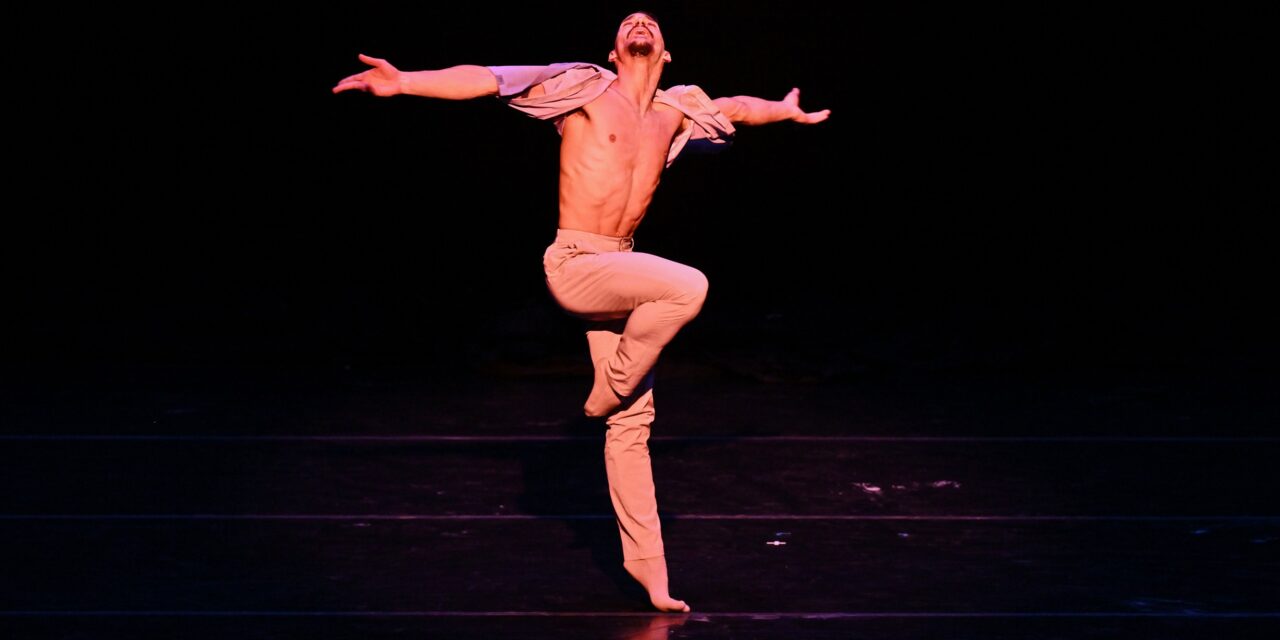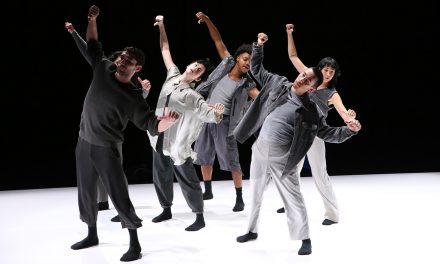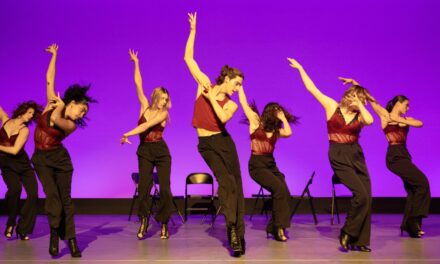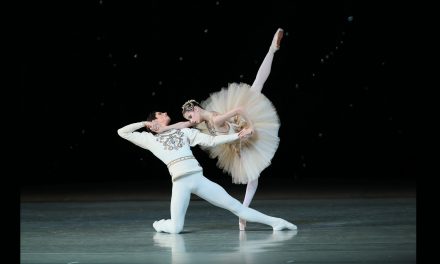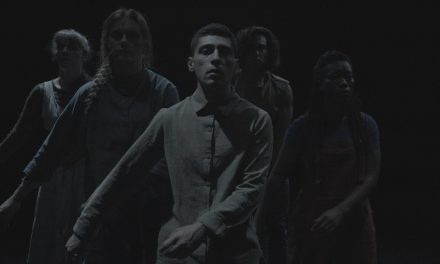Along with Lillian Barbeito, Artistic Director Tina Finkelman Berkett launched BODYTRAFFIC in Los Angeles in 2007. Ms. Berkett is now focusing on re-envisioning and revitalizing the company by discovering exciting new choreographers and creating challenging programs that showcase incredible dancers doing their best work. The evening at the Wallis Annenberg Center for the Arts did not disappoint. A noted highlight of her career was being a founding member of Mikhail Baryshnikov’s Hell’s Kitchen Dance. With the help of Guzmán Rosado as Associate Artistic Director and resident filmmaker, the company merged film, dance and live music into an exciting kinetic program of four different yet connected modern dance pieces. The evening’s common theme was “how do we find home when feeling that one doesn’t belong.”
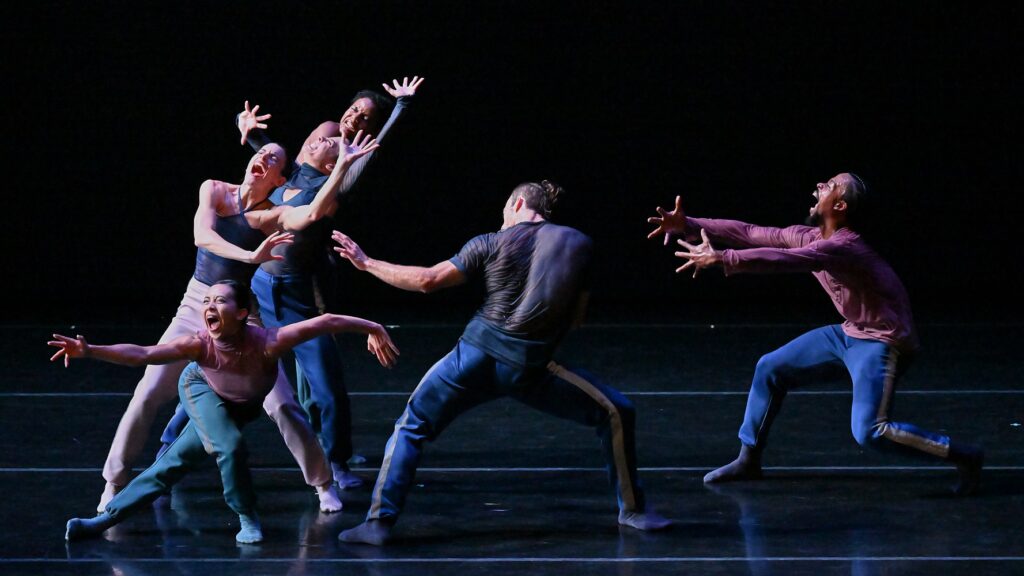
SNAP performed by BODYTRAFFIC: Katie Garcia, Pedro Garcia, Alana Jones, Tiare Keeno, Ty Morrison, Joan Rodriguez and Jordyn Santiago – Photo by Rob Latour/Shutterstock
The night’s first piece, SNAP was choreographed by Micaela Taylor, with music by the iconic James Brown. Inspired by the ethnically diverse crowds of Los Angeles, SNAP recognizes the loneliness that pervades the search for acceptance, urging audiences to ‘snap out of” social pressures to conform. Taylor wanted to express how isolated she felt when moving to LA, and to find her own voice in a patriarchal society. Underscored by the music of Mr. Brown’s THIS IS A MAN’S WORLD, a solo male dancer expresses himself with a blend of hip/hop, blues, jazz and dance-club styles. Eventually joined by six ensemble dancers, the company dances in unison then break off into individual freestyle club moves. The music blends into mashups, sound effects and various versions of the song. The dancing is kinetic and constantly moving, highlighting the limber, energetic and wonderfully trained ensemble. Suddenly the music is interrupted by a voice-over interview of James Brown and a female reporter accentuating the misogynistic times of 60’s black male singers and the macho attitude of that era. The dance becomes an exploration of masculinity as the male dancers interpret the lyrics with hard and violent movements. As the men are joined by the women once again, the dance morphs into a celebration of soul music and how the black community embraced their own style of ‘grooving.’ The vibrant colorful lighting by Burke Wilmore and Kristina Marie Garnet’s dark muted costumes add just enough soul. The company showed such a large vocabulary of street-style blended with modern dance that was so infectious, it was hard to stay in your seats watching them.
BLUE UNTIL JUNE, by choreographer Trey McIntyre was the second piece of the evening. McIntyre caps off a thirty-year career having produced over 100 dance pieces. Inspired by the music of Etta James, ‘her soul-singing and rich reverberatory vocals sets the tone of personal and political turmoil, while immersing ourselves in the seemingly unattainable in order to find our home in love.’ The dance begins with a solo woman, her back to the audience in a posed tableau, while the other five dancers lay undulating under a dark canvas tarp. As the other dancers reveal themselves, they move smoothly changing pairs of duets with the lead dancer. The dancers float across the floor in beautiful soulful lyrical modern movements. Two familiar blues songs, “All I Need” and “If I Can’t Have You,” sync from one musical piece to another, as the dancers alternate between gorgeous lyrical pas de deux, to a quintet of dancers emoting more modern swinging jazz movements and head rolling. James’ haunting rendition of “One More For The Road” sets the stage, as the lead male in an almost drunken state, performs a fun, close to comical modern expressive ballet, as he meets different characters at an invisible bar. Two more songs underscore a series of pas de deux with ever changing partners, expressing the emotions of couples finding love and each other. As the final song one of James’ biggest hits “At Last” begins, we end with the solo lead female finding her perfect companion. The duet displays beautifully executed lifts and extensions within this bluesy ballet. As the remaining dancers slither under the dark tarp and as in the opening, the piece ends with the lead female dancer in her initial tableaux. This time, however, she has a companion. The tie-dyed flowing costumes and soft starry sky backdrop by Sandra Woodall add to the stylistic music and choreography, enhanced by Clifton Taylor’s lighting. It left one with a feeling that love may conquer all.
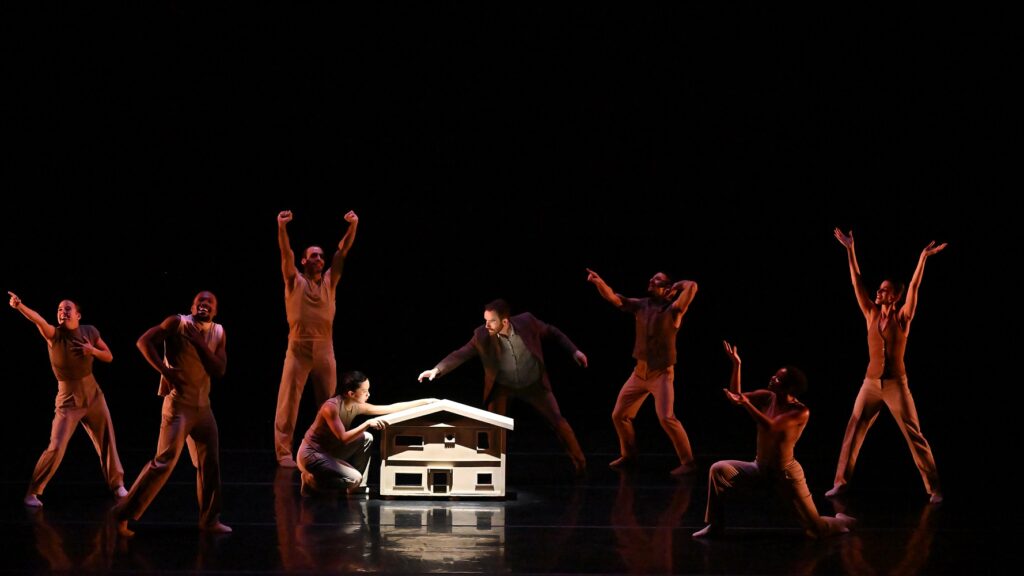
“The Act of Becoming” performed by BODYTRAFFIC: Katie Garcia, Pedro Garcia, Alana Jones, Tiare Keeno, Ty Morrison, Joan Rodriguez, Guzmán Rosado and Jordyn Santiago – Photo by Rob Latour/Shutterstock
After a short intermission, the bare stage opened with an energetic homage to Ravel’s “Boléro,” a World Premiere entitled THE ACT OF BECOMING. Fernando Hernando Magadan’s choreography tells a story of transformations and a reminder that powerful artistic expressions can awaken something dormant within us. The stage is bare except for a small model of a house on a brightly lit stage and a man in a neutral toned suit sitting in a chair. As the famous music begins its’ percussive melody, the man is joined by seven dancers, approaching him with strong antagonistic contemporary movement, challenging him to get up. The eerily changing lighting from dark to light and dark again is by Michael Jarett. The neutral-toned sleeveless tops and loose flowing pant costumes are by Angela Manke.
Throughout the piece, it seems as if the dancers are trying to tell the suited man a story through their movements, as he is thrown around, limply falling into the arms of the dancers. A young female voiceover echoes over the rhythmic music, talking rampantly and apparently trying to explain what they are feeling. The dance becomes more frenetic as each dancer pursues the man, trying to tell their story. One dancer enters the stage with a drum, emphasizing the rhythm and military beats of the music. As the music simplifies to a single drumbeat, the main dancer becomes more active in his movements, copying the earlier moves of the dancers, in an attempt to recreate their story. As he approaches each dancer, they pause and laugh or smile and then continue moving in unison to the syncopated steps. The modern dance styles appear celebratory as the entire ensemble becomes more tumultuous. The piece ends with the main character and a female dancer, as the music is replaced with the voice-over trying to explain what has happened. It sounded like an explanation of foreplay finally reaching the eventual orgasm in voice, music and dance.
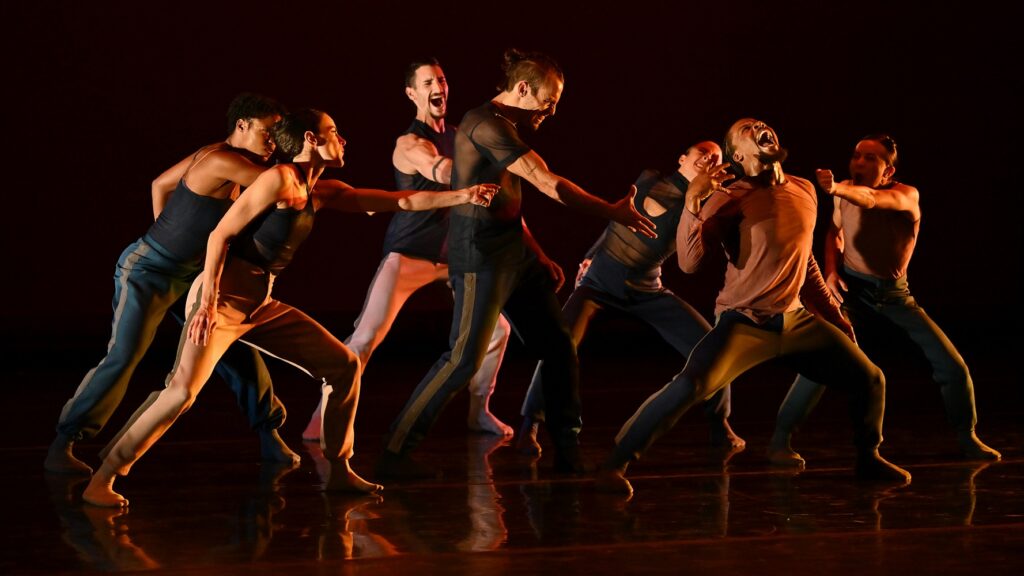
SNAP performed by BODYTRAFFIC: Katie Garcia, Pedro Garcia, Alana Jones, Tiare Keeno, Ty Morrison, Joan Rodriguez and Jordyn Santiago
The evening’s final piece, another World Premiere, was by Cuban Choreographer Joan Rodriguez called BLOQUEA’O. Using the 1962 Cuban Missile Crisis as its backdrop, Rodriguez, a Cuban refugee, creates a synthesis of Folklorico and contemporary influences. Pedro Osuna’s original music is a dichotomic composition blending traditional Cuban rhythms, chants, historical news broadcasts, and sounds of Havana streets. The enchanting music is enhanced by the live virtuoso performances of cellist SUUVI and percussionist Ricky Matute, along with additional percussion by Luis Conte. Peppered with news footage of President Kennedy and local footage of Havana, the filmic backdrop enhances the Cuban style modern dance.
The piece opens with Rodriguez alone on the stage whistling a Latin tune until the live musicians join in. He begins a solo dance, then is joined by the ensemble in a series of Latin dances, from Rhumba to Tango stylings. As the music builds, the dancing becomes more acrobatic and energetic. The dance eventually slows down, becoming more emotional until one by one the dancers exit the stage, leaving Rodriguez to dance solo again. The music segues into a mambo-like beat and he is joined by a single woman. A Paso Doble begins as the duo are joined by three more couples. The men are shirtless and more machismo in their moves and as the voiceover of Kennedy increases in volume over the music, the ensemble begins dancing in unison, with the writhing bodies moving less celebratory and more angst driven. Images of Castro and the evacuation of Cuban take over the filmic backdrop as the dance builds to a frenzy. Then it ends abruptly in a blackout. Throughout the piece, the human connections narrate the piece in its emotional movement and visuals, transporting us to another time while fully experiencing the drama and repetition of the politics of our current times.
The skillful, terrific and tireless BODYTRAFFIC dance ensemble are Katie Garcia, Pedro Garcia, Alana Jones, Tiare Keeno, Ty Morrison, Joan Rodriguez, Jordyn Santiago and Guzman Rosado. The choreography is very exciting, and the evenings four creative works were a cohesive set of new and exciting performance pieces. I look forward to more World Premieres by this company.
To learn more about BODYTRAFFIC, please visit their website.
To find out more about The Wallis, please visit their website.
Written by Anthony Marciona for LA Dance Chronicle.
Featured image: BODYTRAFFIC – Pedro Garcia performing in Blue Until June – Photo by Rob Latour/Shutterstock

